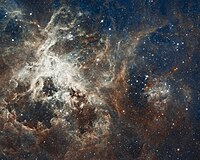Cassini spacecraft captures large storm on Saturn
Friday, July 8, 2011

Image: spacetelescope.org.
On Wednesday NASA released details of a giant convective storm on Saturn gathered from the international Cassini spacecraft orbiting the planet. The storm, known as a "Great White Spot", is around 6,200 miles (10,000 kilometers) wide and visible from Earth.
The White Spot storms have been observed since 1876 and occur approximately every 30 years; only five previous storms have been seen in the last 137 years. The first signs were detected on December 5, 2010 by instruments aboard the Cassini spacecraft when it recorded lightening outbursts in a small bright area on Saturn's northern half. The area was tracked by the spacecraft and by astronomers on the ground through telescopes. It was later identified as a brewing storm during the start of Saturn spring. Its size and intensity grew until its tail wrapped around the planet. It now covers 1.5 billion square miles.
Cassini has been monitoring storms on Saturn since the craft arrived there in 2004. This is the most intense yet seen and was observed in unprecedented detail, according to the journal Nature in two papers published Thursday. The storm is 500 times larger than the biggest storm on Saturn monitored by Cassini. The spacecraft's instruments showed the rate of the nearly continuous lightning flashes was up to ten times more frequent than during past storms it has monitored. This electrical activity is 10,000 times stronger than lightning bursts measured on Earth.
Saturn's huge storm is bright due to its gaseous content, scientists say.
A key question is the source of the energy powering Great White Spots. Originally researchers thought the storms' power might come from the sun. However, researcher Agustin Sánchez-Lavega told Space.com the new data showed that to make sense of the cloud patterns, the winds must "extend deep into the 'weather layer' ... where the main clouds reside." Since sunlight does not reach this depth, this "points to the action of an internal heat source as the power for the winds."
Related news
- "Saturn moon Enceladus may have salty ocean" — Wikinews, June 23, 2011
- "Cassini discovers organic material on Saturn moon" — Wikinews, March 28, 2008
- "Massive hurricane spotted on Saturn" — Wikinews, November 11, 2006
- "Cassini photographs possible lakes on Saturn's moon, Titan" — Wikinews, July 30, 2006
- "Astronomers find changes in Saturn's rings" — Wikinews, September 7, 2005
- "Cassini discovers Saturn moon atmosphere" — Wikinews, March 19, 2005
Sources
- "Saturn's Great White Spot Storm Rages" — MyFoxla.com, July 8, 2011
- A. Sánchez-Lavega et al.. "Deep winds beneath Saturn’s upper clouds from a seasonal long-lived planetary-scale storm" — Nature, July 7, 2011
- G. Fischer et al.. "A giant thunderstorm on Saturn" — Nature, July 7, 2011
- Charles Q. Choi. "Storm as Wide as Earth Rages on Saturn" — Space.com, July 6, 2011
- Elizabeth Weise. "Saturn's Great White Spot spring storm" — USA Today, July 6, 2011
- Alicia Chang (Associated Press). "Spacecraft eyes raging storm, lightning on Saturn" — Forbes, July 6, 2011
- Press Release: "Cassini Spacecraft Captures Images and Sounds of Big Saturn Storm" — prnewswire.com, July 6, 2011
External links
- Jia-Rui Cook, Dwayne C. Brown. "Cassini Spacecraft Captures Images and Sounds of Big Saturn Storm" — July 6, 2011
- "Cassini - Unblocking Saturn's secrets" — NASA,
